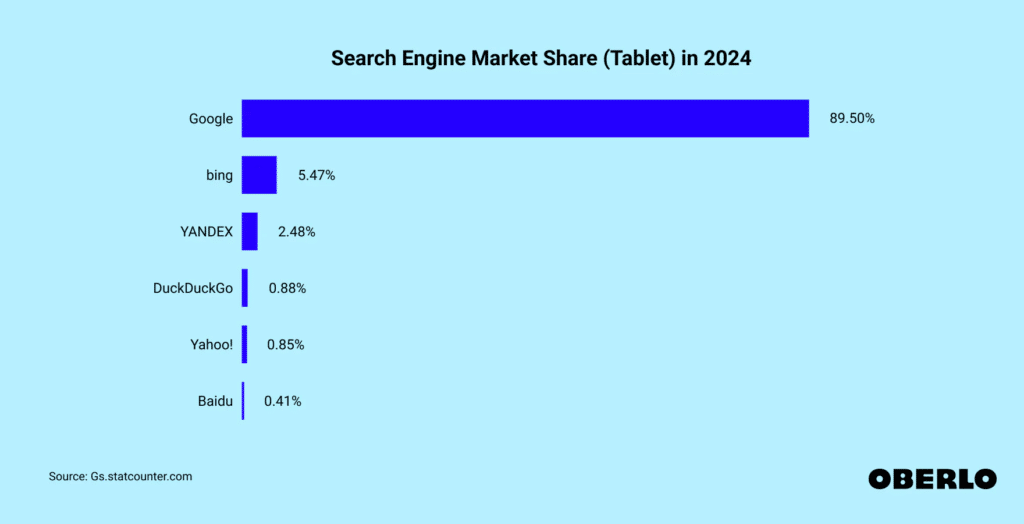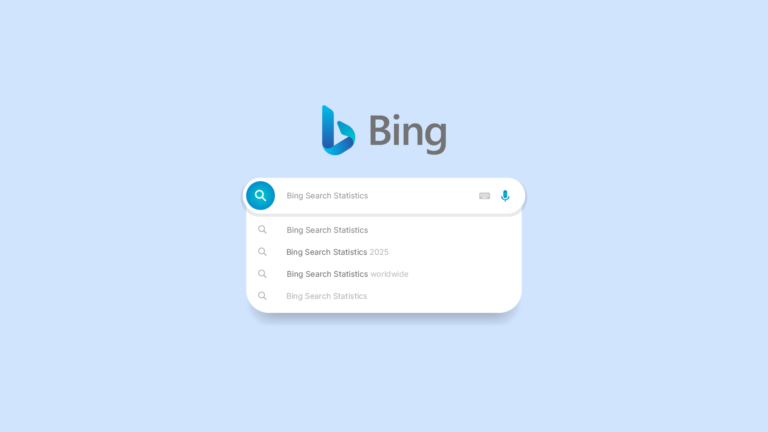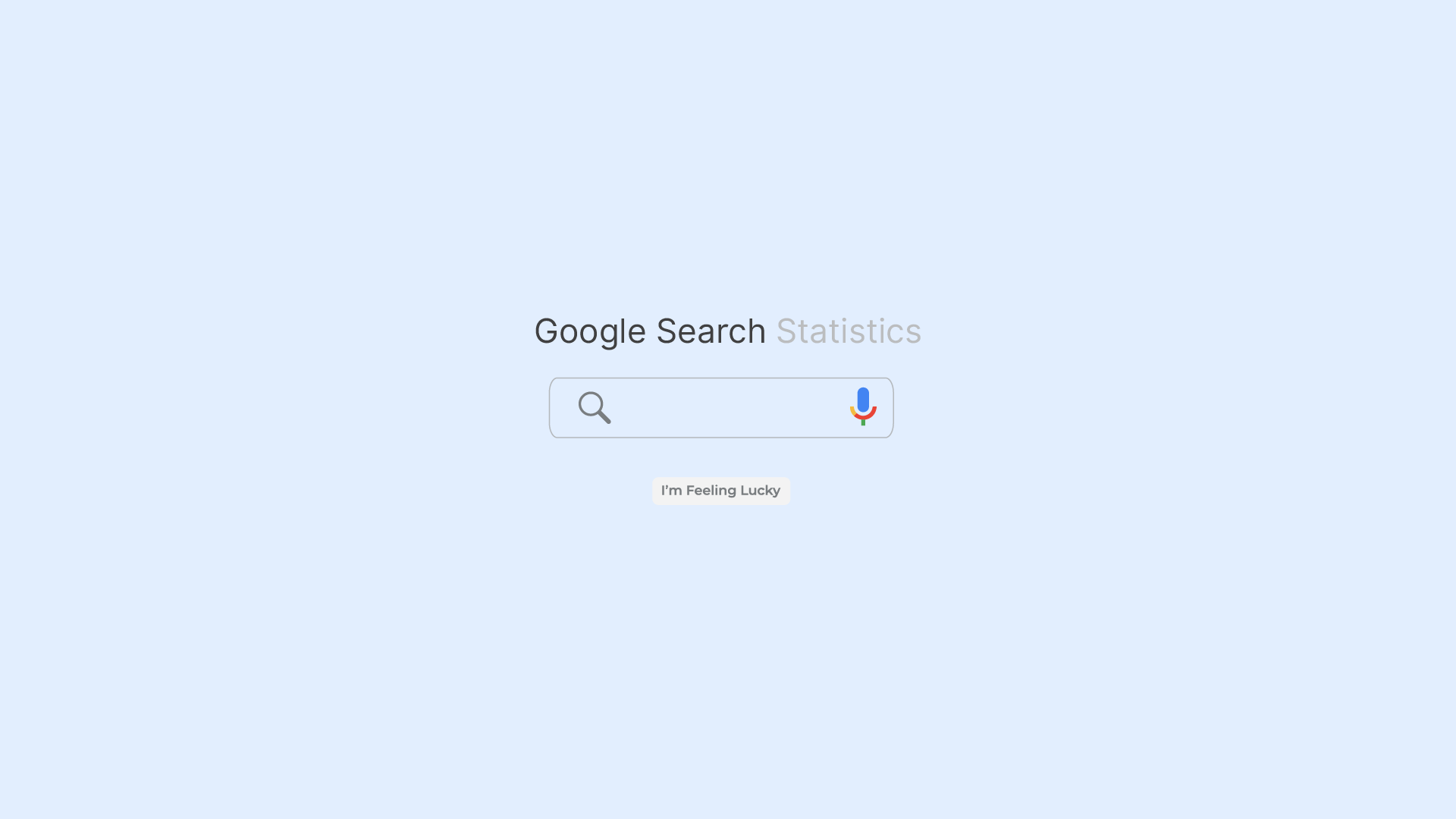Do you know people Google many times a day but rarely Bing? That’s because Google has led the internet search engine market for over a decade—so much so that the term Google has become synonymous with internet search. Meanwhile, Microsoft launched Bing in June 2009, which is now the second-most popular search engine after Google.
However, with recent developments—particularly the integration of AI chat features—Bing is gaining renewed attention. The rise of AI-powered search engines, especially with Microsoft’s launch of an AI-powered search feature on Bing in February 2023, has significantly boosted traffic and user engagement.
Let’s dive deep into the current state of Bing, including its market share, usage trends, and the exciting future prospects. Presenting the top Bing statistics and facts for 2025!
Quick Facts About Bing
Second-Largest Search Engine: Bing holds the runner-up position behind Google.
Global Availability: Microsoft Bing is available in 238 countries or regions and 105 different languages.
Monthly Usage: Bing is used by around 4.04% of people worldwide each month as of January 2025.
Revenue From Search Ads: In FY2023, Microsoft generated $12.31 billion from Bing search ads.
Most Searched Term on Bing: Surprisingly, “YouTube” is the most searched term on Bing in the United States.
Popularity on Desktop: Bing is more popular among desktop users than mobile users.
Ranking Among Websites: The official Bing site sits at #30 worldwide among all websites on the internet.
Bing Web Search: Bing web search is a crucial tool for product research and brand discovery, with many users leveraging it for planning purchases and travel.
Bing’s integration with Windows OS, Xbox consoles, and the Microsoft ecosystem as a whole has created unique opportunities for both general users and businesses. By default, Bing is the search engine for the Microsoft Edge browser and the search box in Windows, offering an often-overlooked advantage in user reach.
Bing Market Share: Bing’s Position in the Search Engine Landscape
Although Bing’s market share is relatively small compared to Google, it still represents a significant portion of the global search engine market. Microsoft’s search engine, Bing, has shown notable customer satisfaction scores, often compared favorably to Google’s on the American Customer Satisfaction Index.
Considering Bing’s higher concentration of desktop users and the Microsoft ecosystem, businesses can find valuable leads here—especially for markets such as the U.S. and certain console users.

Bing Search Engine Market Share Over Time
| Year | Market Share |
| 2009 | 2.30% |
| 2010 | 3.46% |
| 2011 | 3.57% |
| 2012 | 3.09% |
| 2013 | 3.36% |
| 2014 | 3.63% |
| 2015 | 3.02% |
| 2016 | 2.79% |
| 2017 | 2.76% |
| 2018 | 2.82% |
| 2019 | 2.44% |
| 2020 | 2.70% |
| 2021 | 2.58% |
| 2022 | 3.19% |
| 2023 | 2.90% |
| 2024 | 3.72% |
| 2025 | 3.95% |
Bing made some initial headway, but it has consistently remained in Google’s shadow.
Bing searches reveal interesting geographic statistics and popular search queries. For instance, in the United States, Bing holds a more sizable chunk: 7.46% of the search engine market share overall, and 11.84% of the desktop search engine market share. Notably, Bing has a market share of 38.46% among U.S. console users (Xbox), making it the most successful market for Microsoft’s search engine.
Other interesting insights:
44 million desktop searchers use Bing exclusively, not turning to Google at all.
Some surveys claim that 23% of business executives have indicated a preference for Bing.
Over 26% more branded searches on Bing compared to Google.
Context: The strong presence among desktop and console users hints that Bing’s user base might be more stable and potentially more affluent, giving advertisers a chance to target certain demographics more precisely.
Bing Usage Statistics Geographic Breakdown
1.4 Billion Monthly Visits: In February 2025, Bing.com saw more than 1.4 billion visitors globally.
Bing users belong to diverse demographic groups, including various age ranges and educational backgrounds, with a notable portion being parents and individuals in specific life stages.
Highest Traffic from the U.S.: The United States contributes 30.23% of overall traffic, followed by China (10.84%), India (7.34%), Germany (4.61%), and the UK (4.13%).
| Country | Traffic Share |
| United States | 30.23% |
| China | 10.84% |
| India | 7.34% |
| Germany | 4.61% |
| United Kingdom | 4.13% |
| Other Countries | 29.10% |
Bing Demographics and Language Support
Bing’s user demographics reveal a diverse and dynamic audience. Notably, 44% of Bing users are under the age of 45, indicating a strong presence among younger internet users. This demographic diversity is further highlighted by the gender distribution, with males making up 56% of the user base and females accounting for 44%.
One of Bing’s standout features is its extensive language support. Available in 105 different languages, Bing is a truly global search engine platform. This wide-ranging language support includes popular languages such as English, Spanish, French, German, and Chinese, among many others. This accessibility makes Bing a preferred choice for users worldwide, setting it apart from other search engines that may not offer such comprehensive language options.
Bing’s commitment to supporting a multitude of languages not only enhances user experience but also broadens its reach, making it a versatile tool for users across different regions and linguistic backgrounds.
Top Queries on Bing
Within the U.S., the top three queries on Bing searches are Facebook, YouTube, and Google. These popular search queries highlight the diverse interests of Bing users in the U.S.
| No. | Query | Number of Searches |
| 1 | 12,983,821 | |
| 2 | youtube | 11,452,722 |
| 3 | 8,060,698 | |
| 4 | gmail | 6,043,283 |
| 5 | bing homepage quiz | 5,578,736 |
| 6 | amazon | 4,838,409 |
| 7 | bing | 4,620,531 |
| 8 | news for you | 4,298,308 |
| 9 | yahoo | 3,746,439 |
| 10 | ebay | 3,428,642 |
Surprisingly, three of these top ten queries (Google, Gmail, YouTube) are related to Google’s products or services, indicating that many Bing users still navigate to Google.
Demographics and Search Volume
Gender: 62.48% of users identify as male, and 37.52% as female.
Education: 34% of Bing users are college graduates.
Top Age Group: 25–34-year-olds lead usage at 25.6%, followed by 18–24-year-olds at 19.67%.
Search Volume: Bing sees over 100 million searches per day. That translates to ~27 billion searches per month, ~37.5 million per hour, ~625 thousand per minute, and ~10,417 searches per second.
Marketers may find Bing’s user profile particularly appealing for higher-end products and services, as studies suggest Bing users often have higher household incomes and spend more online.
Bing Search and AI-Powered Features
Bing’s AI-powered search engine is a game-changer in the world of search engines. Leveraging advanced AI technology, Bing provides more accurate and relevant search results, setting it apart from its competitors. This AI capability allows Bing to understand natural language queries, making it easier for users to find exactly what they’re looking for.
Bing’s AI-powered features extend beyond search queries. They include sophisticated image and video recognition and entity recognition, which helps identify and categorize various elements within search results. These innovations significantly enhance the overall user experience, making searches more intuitive and efficient.
By integrating AI into its search engine, Bing improves the accuracy of search results and offers a more personalized and user-friendly experience. This focus on AI-driven search capabilities positions Bing as a forward-thinking player in the search engine market.
Bing Customer Satisfaction and Daily Usage
Bing’s customer satisfaction is a testament to its effectiveness and user-centric approach. Among American internet users, Bing boasts a customer satisfaction score of 75 out of 100, indicating a high level of satisfaction. This score reflects Bing’s commitment to providing a reliable and enjoyable search experience.
Daily usage statistics further underscore Bing’s popularity. With 100 million daily active users worldwide, Bing’s significant daily usage highlights its strong user loyalty and widespread acceptance. These metrics are key indicators of Bing’s success in the competitive search engine market.
Bing’s high customer satisfaction and substantial daily usage result from continuous improvements and a focus on enhancing user experience. These factors contribute to Bing’s growing reputation as a dependable and user-friendly search engine.
Bing Ads Statistics Revenue Trends
Bing’s advertising revenue has steadily increased:
| Financial Year | Revenue (USD) |
| 2024 | $12.58 billion |
| 2023 | $12.21 billion |
| 2022 | $11.59 billion |
| 2021 | $8.53 billion |
| 2020 | $7.74 billion |
| 2019 | $7.63 billion |
| 2018 | $7.01 billion |
| 2017 | $6.22 billion |
| 2016 | $5.43 billion |
The average revenue per user has also climbed over time, reaching $9.66 in 2022.
Ad Metrics
Across all industries, Bing Ads sees the following averages:
CTR (Click-Thru Rate): ~2.83%
CPC (Cost Per Click): ~$1.54
Conversion Rate: ~2.94%
CPA (Cost Per Action): ~$41.44
Context: The often lower CPC on Bing Ads can be attractive for small and mid-sized businesses looking to stretch their advertising budget further than they might on Google.
The Bing Chat Revolution
Bing’s recent integration with ChatGPT technology has generated renewed excitement, positioning Microsoft’s search engine as a potential challenger to Google. The rise of ai powered search engines is exemplified by Microsoft’s launch of an AI-powered search feature on Bing in February 2023. This integration with GPT-4 significantly boosted traffic and user engagement for Bing, illustrating the growing trend of utilizing AI technology in search engines to enhance performance and attract users.
100 Million Daily Active Users: A month after Bing Chat launched, it surpassed 100 million daily users.
Launch Date: Bing Chat was introduced in early February 2023.
Rapid Adoption: Over 1 million people joined the waitlist for Bing Chat within 48 hours of its announcement.
45 Million Chats: In just a few weeks, Bing Chat saw 45 million conversations.
With AI-driven search experiences becoming the new frontier, Bing’s adoption of ChatGPT puts Microsoft in direct competition with Google’s Bard and other AI tools. This shift could reshape the entire search market.
Bing’s Competitive Advantage
Bing’s competitive advantage lies in its innovative approach to search engine technology and its focus on user experience. The integration of AI-powered features is a key differentiator that sets Bing apart from other search engines. This advanced technology not only improves search accuracy but also enhances the overall user experience.
Another significant advantage is Bing’s extensive language support. Being available in 105 different languages, Bing caters to a global audience, making it a versatile and accessible search engine platform. This wide-ranging language support is a major factor in Bing’s global appeal.
Bing’s commitment to improving user experience and customer satisfaction has also played a crucial role in its success. By continuously innovating and focusing on user needs, Bing has carved out a unique position in the search engine market. Its competitive advantage is a result of these combined efforts, making Bing a formidable contender in the industry.
How Much Is Bing Worth?
Official data is sparse, but estimates place Bing’s valuation at around $400 billion in 2025. This figure has reportedly grown year over year, reflecting how Bing’s consistent user base and ad revenue continue to drive substantial value for Microsoft.
Bing’s valuation underscores the significant role it plays in Microsoft’s ecosystem, from advertising to data collection to supporting Microsoft’s other services.
Final Take on Bing Statistics
There you have it—an expanded overview of Bing’s current state, usage, and market share. While Google remains the giant in search, Bing continues to grow, especially with the buzz around its AI-driven chat features. Whether you’re a casual user, a marketer, or a business professional, these statistics emphasize Bing’s evolving role in the search ecosystem.
With Microsoft’s continued investment—ranging from integrating Bing into the Windows OS and Xbox to harnessing AI chat capabilities—Bing could become a more formidable contender over time. Will it ever catch Google? Only time will tell, but the search engine industry is undoubtedly more dynamic than it has been in years.
If you’re looking to diversify your marketing efforts or explore new opportunities in search engine optimization, Bing should definitely be on your radar. Its unique user base, integrated services, and growing AI capabilities make it a platform worth watching—and investing in.
Feel free to use these Bing statistics and facts wherever you need them, whether it’s for market research, presentations, or blog content. Stay ahead of the curve by monitoring Bing’s innovations and shaping your strategies accordingly.
Frequently Asked Questions
When was Bing created?
Microsoft released Bing on June 3, 2009. Bing launched with initial traction in the search engine market and has gradually increased its market share against Google.
How much is Bing Worth?
Bing’s estimated worth is around $400 billion in 2025.
How many users does Bing have?
An estimated 1.1 billion users worldwide in 2024.
Which is the second-largest search engine?
Bing is considered the second largest search engine globally.
What was Bing’s market share in 2025?
As of January 2025, Microsoft’s Bing held a 12.23% share of the global desktop search market, positioning it as a significant player despite Google leading with approximately 78.83%. In comparison, Yahoo maintained a market share of 3.07%.
What percentage of people use Bing search?
As of January 2025, approximately 4.04% of people worldwide use Bing each month.
How do I enable Bing statistics?
To enable Bing statistics, you can use the Bing Webmaster Tools, which provide insights into search performance and user engagement.
Is there a Bing Analytics?
Yes, Bing offers analytics through its Bing Webmaster Tools, which allow you to track search performance, crawl data, and more.
What is the #1 search on Bing?
In the United States, the most searched term on Bing is “YouTube.”
How many users does Bing have?
Bing had an estimated 1.1 billion users worldwide in 2024.
Which is the second-largest search engine?
Bing is considered the second-largest search engine globally, following Google.
What was Bing’s market share in 2024?
Bing’s market share was approximately 3.72% in 2024.







